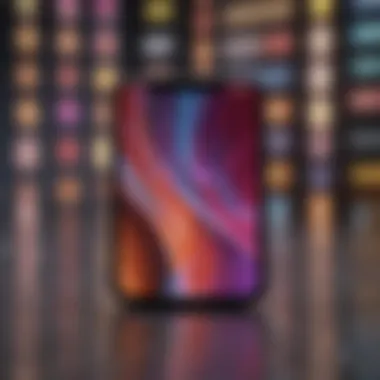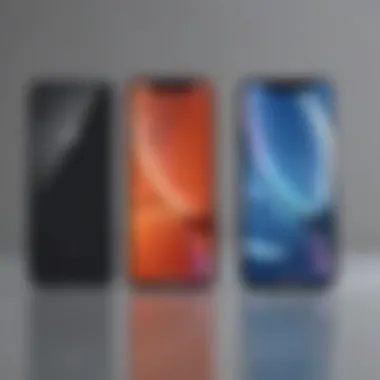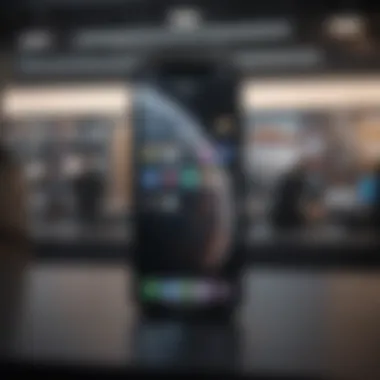Exploring the Largest iPhone Screen of 2021


Intro
The evolution of smartphone displays is a pivotal thread in the narrative of technological advancement. With each iteration, manufacturers have redefined user interaction through enhanced screen real estate. 2021 marked a significant milestone in this evolution, particularly with the launch of Apple's flagship device featuring the largest iPhone screen to date. This article will delve into the specifics of this large display, its implications on usability, and the broader trends it signifies within the smartphone market.
Overview of the Display
Definition
Apple's largest screen, featured in the iPhone 13 Pro Max, spans a generous 6.7 inches. This measurement is indicative of a growing trend, where screen size plays an integral role in user experiences. A larger screen allows for enhanced visibility, making it more suitable for various activities such as gaming, streaming, and productivity tasks.
Key Features
The display itself is a Super Retina XDR panel, which boasts impressive brightness levels, color accuracy, and contrast. This technology employs OLED to deliver deep blacks and vibrant colors. The inclusion of ProMotion technology enhances fluidity during scrolling and interactive tasks. All combined, these features elevate the overall experience.
Purpose and Benefits
The primary purpose of a larger screen is to enhance usability. Users benefit from improved legibility and greater surface area for multitasking. The larger real estate also fosters a more immersive viewing experience, whether that be for watching movies or playing games.
User Experience Considerations
The increased screen size affects user interaction in several ways. It allows for better visibility of content, less need for zooming, and an overall enhanced experience in apps. However, the size can also lead to challenges. One of the prominent issues is one-handed usability, which might be compromised due to the phone's dimensions. Users often need to adjust their grip or switch hands, which may not be conducive to all activities.
Broader Context in the Smartphone Market
As the smartphone market matures, manufacturers continually race to optimize device dimensions while also catering to consumer preferences. The significant move towards larger screens aligns with consumer demands for greater visuals and immersive experiences. It is essential to observe how competitors respond with their respective flagship devices and how quickly they adapt to these market dynamics.
The shift towards larger screens is reflective of evolving consumer desires and the ongoing trend of prioritizing multimedia consumption and productivity.
Prelude to iPhone Screen Sizes
Understanding iPhone screen sizes provides valuable insight into the evolving landscape of mobile technology. It sets the foundation for comprehending how screen dimensions impact user experiences, design choices, and functionality in today’s smartphones. The emergence of larger displays is not merely a trend; it reflects shifts in consumer preferences and emerging technologies. An exploration of this topic reveals the significance of display size in a user’s daily interactions with their device.
Historical Overview of iPhone Displays
The journey of iPhone displays has been remarkable since the first model was released in 2007. The original iPhone featured a modest 3.5-inch screen, which was a substantial innovation at its time. As technology advanced, Apple steadily increased display sizes to meet the demands of its users.
In 2010, the introduction of the iPhone 4 brought a 3.5-inch Retina display, enhancing clarity significantly. The iPhone 5, released in 2012, expanded the screen to 4 inches. Subsequent models like the 6 and 6 Plus in 2014 marked a pivotal moment with 4.7 inches and 5.5 inches respectively. Each transition represented a blend of design evolution and user preference, indicating a clear trend toward larger screens. By the time of the iPhone 13 Pro Max in 2021, users experienced a substantial 6.7-inch display, reflecting both technological advancements and changing consumer expectations.
Significance of Screen Size in Smartphones
Screen size plays a crucial role in determining usability and functionality across smartphones. A larger display is often associated with improved media consumption capabilities, providing a better experience for watching videos, reading, and browsing the web. Users value a larger screen for multitasking, allowing them to view multiple applications simultaneously.
Furthermore, the growing trend toward larger screens can also enhance accessibility. It can make text more readable and controls easier to interact with, benefiting users of all ages. However, challenges such as portability and one-handed use are important considerations that manufacturers must balance.
In brief, the size of a smartphone display directly influences how users engage with their devices, making it a vital aspect of modern smartphone design. Companies must adapt to these preferences, ensuring their devices meet the needs of an evolving market.
The Relevance of the Largest iPhone Screen in
The introduction of larger smartphone screens has shifted consumer preferences, with many users seeking devices that offer expansive displays. The largest iPhone screen in 2021, found on the iPhone 13 Pro Max, became significant not only for its size but also for what it represented in the broader smartphone landscape. The relevance of this development lies not just in the technological capabilities it presents but also in the implications for usability across various activities such as media consumption, gaming, and productivity.


Prologue of the iPhone Pro Max
Launched in September 2021, the iPhone 13 Pro Max boasted a 6.7-inch display, marking a continuation of Apple’s trend towards larger screens. This model was notable for its Super Retina XDR technology, which improved brightness, color accuracy, and contrast ratio. The increased screen real estate allowed for more immersive experiences whether watching videos, browsing the web, or multitasking through multiple applications. It also featured ProMotion technology that provided a smoother scroll and interaction through a refresh rate of up to 120Hz.
Furthermore, the combination of size and display technology enhanced user experiences, encouraging developers to create apps that utilized the full capabilities of the larger screen. This evolution reflected consumer demands for a device that could serve as a versatile tool for entertainment and productivity alike.
Comparison with the Previous Models
When comparing the iPhone 13 Pro Max with its predecessor, the iPhone 12 Pro Max, one can observe more than just the size increase. While the iPhone 12 Pro Max had a 6.7-inch display as well, the advancements in brightness and processing capabilities in the iPhone 13 series were significant. The A15 Bionic chip enhanced performance, which is crucial when harnessing the capabilities of a large screen.
Here are some key differences:
- Brightness: The iPhone 13 Pro Max offered an increased peak brightness level, making it more suitable for outdoor use.
- Color Accuracy: Improved color calibration allowed for better representation of images and videos.
- Software Optimization: iOS updates optimized interfaces to work more fluidly with the larger screen dimensions.
The shift in user interaction with technology is often framed by the evolution of display sizes, transforming how tasks are completed on mobile devices.
This trend results in devices that cater to heavy media consumers and multitaskers. Users found significant benefits from the accessibility of controls and information on a larger display, significantly influencing purchasing decisions. With competitors also pushing larger screens, the iPhone 13 Pro Max represented Apple’s commitment to staying ahead in the market.
Technical Specifications of the Largest Screen
In understanding the largest iPhone screen, technical specifications emerge as a critical component. They hold valuable insights into the performance, usability, and quality of the display. Analyzing the technical aspects not only highlights what makes this screen stand out but also informs buyers about what they can expect regarding usability and interaction.
Size and Dimensions
The iPhone 13 Pro Max boasts a 6.7-inch screen, making it the largest iPhone display to date. This size offers a significant increase from previous models, most notably the iPhone 12 Pro Max, which features a 6.5-inch screen. The overall dimensions of the device are crucial because they directly affect how easy it is to hold and interact with the phone.
Moreover, the larger screen size allows for a more immersive experience when consuming content, be it videos, gaming, or other visual media. However, it is essential to note that with great size comes the potential challenge of portability. Users who prioritize pocketability may find a large device slightly cumbersome. Therefore, understanding the balance between size and functionality is key for potential buyers.
Display Technology
The iPhone 13 Pro Max utilizes Super Retina XDR technology. This means it employs OLED technology, which offers better contrast, vibrant colors, and deeper blacks compared to traditional LCD displays. The significance of this is multifaceted. First, OLED technology enhances the visual appeal of everything from photos to videos.
In addition, this type of display tends to consume less battery power when displaying darker images, leading to improved energy efficiency. This efficiency is crucial for users who rely heavily on their phones throughout the day. Therefore, not only does the display look better, but it also contributes to better battery life.
Resolution and Aspect Ratio
The resolution of the iPhone 13 Pro Max is 2778 x 1284 pixels. This high resolution, combined with an aspect ratio of 19.5:9, means that images are sharp, and details appear crisp. High resolution plays a vital role in enhancing the user experience, especially when viewing high-definition content. Users can enjoy a more detailed and immersive viewing experience.
It should also be noted that the aspect ratio supports a wide range of media consumption, black bars are minimized during video playback, and the formatting aligns well with common video dimensions. Thus, both resolution and aspect ratio significantly contribute to the screen’s overall effectiveness and consumer appeal.
As smartphone screens continue to evolve, their technical specifications will remain a crucial factor in determining their usability and user satisfaction.
Understanding the technical specifications surrounding the largest iPhone screen in 2021 presents potential buyers with the necessary knowledge to make informed decisions. It helps to clarify the benefits and drawbacks of such an extensive display, thereby enhancing overall user awareness in a continually growing market.
User Experience with Larger Screens
The experience of using larger smartphone screens has significant implications for various tasks. Larger screens offer a better visual space, improving interaction and engagement with content. For the iPhone 13 Pro Max, the user experience is fundamentally changed, influencing how people communicate, consume media, and play games. The ability to see more on the screen leads to increased productivity and enjoyment in daily smartphone tasks.
Impact on Usability
Usability is crucial when assessing the user experience. A larger screen on the iPhone 13 Pro Max provides additional real estate for applications. This leads to enhanced accessibility but also can introduce some challenges.


- Text Readability: Larger screens make it easier to read text without straining the eyes. This benefit is paramount for users engaging in reading and browsing.
- Multi-tasking: Users can work with multiple applications side by side without switching back and forth continually. This can be essential for professionals needing to check emails while reviewing documents.
- Navigation: While many find larger screens beneficial, some users may struggle with one-handed operation. It is sometimes awkward to reach the far edges of the display.
The advantages generally weigh heavier than the negatives. The usability improvements encourage longer interaction times and transfer into overall satisfaction.
Enhanced Features for Media Consumption
The iPhone 13 Pro Max’s larger display transforms media consumption. Larger screens lead to a more immersive experience when watching videos or playing games. Users typically notice these enhancements:
- Video Clarity: Higher resolutions available on larger screens make video playback smooth and visually appealing.
- Cinematic Experience: Watching movies or shows appears more like a theater experience. Watching widescreen films on this device adds depth to the visuals.
- Enhanced Graphics: Games designed for larger screens show improved graphics and deeper colors, making gameplay a visually rewarding experience.
Overall, larger screens are becoming crucial for user engagement in media applications. The ability to enjoy high-quality visuals enhances the user experience significantly.
Considerations for Mobile Gaming
For mobile gamers, the advent of larger screens changes the landscape of gaming entirely. Here are some aspects where larger displays excel:
- Control Layout: Gaming interfaces can spread out, allowing for better control and responsiveness.
- Visual Precision: The detail visible on larger screens offers a competitive edge in gaming. Players can read small details that might go unnoticed on smaller displays.
- Battery Performance: The graphics demand is higher, which may lead to increased battery consumption. This consideration is important for gamers who want to play for extended periods.
In summary, mobile gaming thrives on larger displays, enabling intricate visuals and complexities in gameplay that small screens cannot provide. This aspect of user experience shows that larger screens cater perfectly to certain audiences who prioritize gaming as a core function of their mobile device.
Consumer Preferences in Smartphone Displays
Understanding consumer preferences in smartphone displays is pivotal in today's competitive market. With tech-savvy users, the significance of display size extends beyond mere aesthetic appeal. It embodies usability, functionality, and overall user satisfaction. In 2021, as smartphones continue to evolve, preferences shape and shift, dictating the direction of innovations and designs.
Market Trends in Display Sizes
The trend towards larger display sizes began several years ago and shows no signs of reversal. Market analysis indicates a significant consumer shift favoring screens over six inches. This trend correlates strongly with the increasing popularity of multimedia consumption, such as streaming and gaming. In addition, larger screens enhance the experience for productivity tasks, ranging from document editing to video conferencing. The rise in demand for larger displays has compelled manufacturers to rethink design strategies to maintain balance between usability and portability.
Impact of Larger Displays on Sales
- Sales Growth: Companies have reported that models featuring larger screens often experience higher sales figures.
- Variation in Offerings: To cater to diverse consumer needs, brands like Apple have diversified their offerings, including both large and compact models.
- Consumer Segmentation: Different demographics favor different sizes. Young professionals may prefer larger screens for work, while families might focus on features tailored for shared media consumption.
Survey on User Preferences
Numerous surveys highlight which smartphone display features are most valued among users. Some common findings include:
- Screen Real Estate: Many users cite screen size as a key factor when choosing a smartphone. Larger screens enable easier navigation and improved readability.
- Battery Life: Users are increasingly concerned about battery performance in relation to screen size. Those opting for larger displays often want assurance of robust battery life.
- Weight and Portability: Despite preferring larger displays, users also express concerns about the increased weight and bulkiness of larger devices. Manufacturers must strike a balance here.
"A significant portion of smartphone users regards display size as essential, simultaneously desiring portability and functionality."
Aesthetic Considerations
Beyond functionality, aesthetics plays a crucial role in consumer preferences regarding smartphone displays. Users gravitate towards devices that offer appealing designs, including aspects such as:
- Screen-to-Body Ratio: A higher ratio indicates a sleeker appearance and maximizes viewing area without significantly increasing device size.
- Color Accuracy and Contrast: Enhanced visual quality is crucial, especially for creative professionals or avid media consumers. This impacts how users perceive and select devices.
- Finish and Materials: The materials surrounding the screen, whether metal, glass, or plastic, contribute to overall aesthetics and user satisfaction.
This focus on aesthetics continues as brands innovate and push boundaries, seeking to create devices that are visually striking and functionally superior. Understanding these elements allows manufacturers to align their designs with consumer expectations.
Challenges with Larger Displays
The evolution of smartphones, particularly iPhones, has led to a significant increase in screen sizes. While larger displays provide various advantages, they also come with noteworthy challenges. This section examines the inherent issues that arise with larger screens, focusing on portability and durability.


Portability versus Screen Size
One of the primary concerns with larger smartphone displays is the balance between portability and usability. A larger screen enhances the visual experience for users, making activities like browsing, streaming, and gaming more enjoyable. However, the downside of bigger displays is often increased bulk and weight. Users may find it cumbersome to carry larger devices. This can be especially true for young professionals and students who typically value convenience and portability in their daily lives.
Maintaining comfort in handling is key for user satisfaction.
Several factors influence the overall portability of large-screen smartphones. The physical dimensions of the device, the material used in its construction, and battery size all play critical roles. Phone designs continue to evolve, with companies striving to make larger screens more ergonomic. Some brands even focus on thinner bezels to optimize screen size while keeping dimensions manageable.
Considering that many users carry their phones in pockets or small bags, larger devices may lead to discomfort or inconvenience. Thus, when selecting a smartphone with a big display, buyers must weigh the benefits of enhanced screen real estate against the trade-off of reduced portability.
Durability and Repair Considerations
Along with portability, durability is a crucial topic for larger smartphones. Increased screen size often translates to an increased likelihood of damage during everyday use. Larger screens are more susceptible to cracks and scratches, given the greater surface area exposed to potential hazards. This poses a significant concern for families or students who may handle their devices more roughly.
When it comes to repairs, larger screens may also complicate the process. Finding replacement parts for specific iPhone models can sometimes be challenging, particularly for the latest releases. Repair costs can be higher as well, due to the increased labor involved in handling larger screens.
Thus, users should consider these factors when purchasing a device with a large display. Preventive measures such as screen protectors and rugged cases can offer additional protection. Yet even with precautions, the larger the screen, the greater the need for mindfulness in usage.
Future Trends in Smartphone Display Sizes
The landscape of smartphone displays is constantly evolving. As technology advances, so do the preferences of users regarding screen size and quality. Recognizing future trends in smartphone display sizes is crucial, especially considering the impact these developments have on usability, design, and consumer satisfaction.
Predictions for Upcoming Models
Anticipating the next iterations of smartphones requires a comprehensive understanding of current market dynamics. As demand for larger screens continues to rise, predictions suggest that manufacturers will likely focus on enhancing both size and resolution. Future models may integrate foldable technology, offering users the ability to expand their display when needed, yet maintain portability in compact form. This innovation allows for a seamless transition between tasks like gaming, watching videos, or using applications without sacrificing screen real estate.
Some predicted features include:
- Increased adoption of OLED displays for better color accuracy and contrast.
- A move towards under-display camera technology, allowing for uninterrupted viewing experiences.
- Enhanced durability standards to cater to users who prioritize longevity alongside size.
Technological Innovations on the Horizon
Technological advancements will shape the future of smartphone displays significantly. Key innovations on the horizon may include mini-LED and micro-LED technologies. These newer display types offer advantages, like higher brightness levels and more efficient energy consumption. Brands like Apple and Samsung are already exploring these innovations, hinting at their potential integration into future models.
Moreover, developments in refresh rate technology promise smoother animations and better responses during gaming. Manufacturers are likely to implement higher refresh rates as standard for larger displays, enhancing user experience.
Another critical area is integrating artificial intelligence into display settings. Smart adjustments based on content and lighting conditions can provide optimized viewing experiences that adapt automatically. This could redefine user interaction with mobile devices.
In summary, the future of smartphone display sizes points towards an exciting trajectory. As manufacturers respond to consumer preferences for larger screens, innovations will focus on portability, durability, and advanced technologies. Staying informed on these emerging trends will better equip consumers to choose the ideal smartphone that fits their lifestyle.
Ending and Implications for Consumers
The conclusion section of this article offers a significant recap on the extensive exploration of the largest iPhone screen available in 2021. Visitors have learned how screen sizes have evolved and how current technology allows for larger displays without sacrificing quality. This closing segment emphasizes the importance of informed choice when selecting a smartphone, especially one with an expansive screen.
Summary of Key Points
Understanding the main elements of this topic is vital for consumers who may be overwhelmed by the choices in the smartphone market today. Here are the critical takeaways regarding the largest iPhone screen of 2021:
- Technological Advances: The iPhone 13 Pro Max highlights advancements in display technology. Its Super Retina XDR display delivers impressive accuracy, brightness, and color representation.
- User Experience: Feedback indicates that users appreciate the enhanced media consumption, gaming experiences, and multitasking capabilities offered by larger screens.
- Market Trends: The growth in demand for larger displays continues, reshaping consumer preferences and influencing manufacturer strategies.
- Balanced Considerations: While larger screens offer numerous advantages, potential drawbacks such as portability and repair limitations must also be considered.
Final Thoughts on Choosing a Smartphone with a Large Screen
When it comes to selecting a smartphone with a large screen, there are several considerations that buyers should keep in mind. It is essential to assess personal needs against the features provided by the device. Here are a few points to consider:
- Usage Needs: Identify what the primary use for the smartphone will be. For media consumption and gaming, larger screens can greatly enhance enjoyment.
- Portability: Evaluate how the size impacts daily life. Larger devices may be less portable, which matters for those often on the go.
- Comfort level: The feel of the device in hand is critical. Ensure the size does not compromise comfort in daily usage.
- Price Point: Larger screens typically come with higher price tags. Consider budget constraints when making a choice.
Ultimately, choosing a smartphone is a balance of preference, functionality, and lifestyle needs. The immense display capabilities of the largest iPhone in 2021 reflect both current technology and user demands, making such a device a worthy consideration for many.



